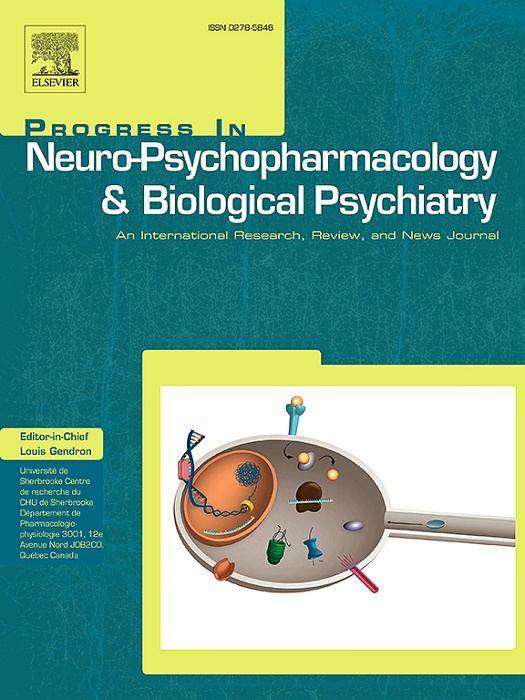High allostatic status impairs cognitive function in patients with first-episode drug-naive bipolar disorder
IF 3.9
2区 医学
Q1 CLINICAL NEUROLOGY
Progress in Neuro-Psychopharmacology & Biological Psychiatry
Pub Date : 2025-06-30
DOI:10.1016/j.pnpbp.2025.111434
引用次数: 0
Abstract
Objective
Patients with bipolar disorder (BD) are often experience cognitive impairment. Allostatic load (AL) represents the cumulative physiological burden on the body resulting from prolonged or chronic stress, which plays a key role in the pathophysiology of BD. This study aimed to investigate the relationship between AL and cognitive function in first-diagnosed, drug-naïve BD patients.
Methods
Patients with BD (n = 113) recruited from March 2019 to August 2022, along with healthy controls (HCs, n = 115) recruited during the same period. Body mass index (BMI), waist-to-hip ratio (WHR), high-density lipoprotein cholesterol (HDL), total cholesterol (TC), blood glucose, C-reactive protein (CRP), cortisol and serum dehydroepiandrosterone (DHEA) levels were measured to calculate AL. Clinical symptoms were assessed using the Hamilton Depression Scale (HAMD), Hamilton Anxiety Scale (HAMA), and Young's Mania Rating Scale (YMRS). Cognitive function was evaluated using the Repeatable Battery for the Assessment of Neuropsychological Status (RBANS) and the Stroop Word Test. Differences in AL, eight biological indicators, and cognitive performance were compared between the BD and HC groups. Covariate analyses were conducted to examine correlations between AL and cognitive function, with further gender subgroups analysis to explore specific factors affecting cognition in BD.
Results
AL levels were significantly higher in the BD group (U = 5096, P = 0.004) compared to HC. Cognitive performance, as measured by RBANS (t = 6.359, P < 0.0001) and Stroop test (t = 4.516, P < 0.0001) scores, was significantly lower in BD patients. Cortisol levels were positively correlated with delayed memory performance (r = 0.29, P = 0.027), whereas CRP levels were negatively correlated with delayed memory performance (r = −0.31, P = 0.020). In the male subgroup, a negative correlation was observed between AL and RBANS scores (r = −0.48, P = 0.009).
Conclusion
Elevated AL may contribute to the pathophysiology of BD and the observed reduction of cognitive performance.
高适应状态损害首发药物型双相障碍患者的认知功能。
目的:双相情感障碍(BD)患者常经历认知障碍。适应负荷(Allostatic load, AL)是长期或慢性应激对机体造成的累积生理负担,在BD的病理生理中起着关键作用。本研究旨在探讨首次诊断为drug-naïve BD患者的AL与认知功能之间的关系。方法:2019年3月至2022年8月招募的BD患者(n = 113),以及同期招募的健康对照组(n = 115)。测量身体质量指数(BMI)、腰臀比(WHR)、高密度脂蛋白胆固醇(HDL)、总胆固醇(TC)、血糖、c反应蛋白(CRP)、皮质醇和血清脱氢表雄酮(DHEA)水平,计算AL。使用汉密尔顿抑郁量表(HAMD)、汉密尔顿焦虑量表(HAMA)和杨氏躁狂评定量表(YMRS)评估临床症状。认知功能评估采用神经心理状态评估可重复电池(rban)和Stroop单词测试。比较BD组和HC组在AL、8项生物学指标和认知能力方面的差异。通过协变量分析检验AL与认知功能的相关性,并进一步进行性别亚组分析,探讨影响BD患者认知功能的具体因素。结果:与HC相比,BD组AL水平显著升高(U = 5096,P = 0.004)。rban测量的认知表现(t = 6.359,P )结论:AL升高可能与双相障碍的病理生理和观察到的认知表现下降有关。
本文章由计算机程序翻译,如有差异,请以英文原文为准。
求助全文
约1分钟内获得全文
求助全文
来源期刊
CiteScore
12.00
自引率
1.80%
发文量
153
审稿时长
56 days
期刊介绍:
Progress in Neuro-Psychopharmacology & Biological Psychiatry is an international and multidisciplinary journal which aims to ensure the rapid publication of authoritative reviews and research papers dealing with experimental and clinical aspects of neuro-psychopharmacology and biological psychiatry. Issues of the journal are regularly devoted wholly in or in part to a topical subject.
Progress in Neuro-Psychopharmacology & Biological Psychiatry does not publish work on the actions of biological extracts unless the pharmacological active molecular substrate and/or specific receptor binding properties of the extract compounds are elucidated.

 求助内容:
求助内容: 应助结果提醒方式:
应助结果提醒方式:


